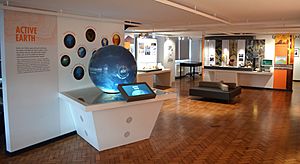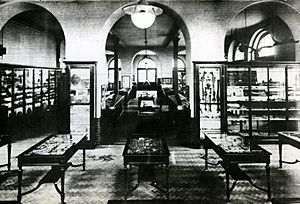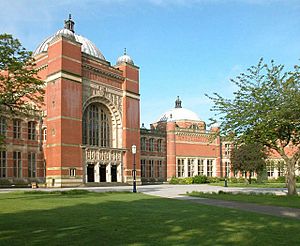Lapworth Museum of Geology facts for kids
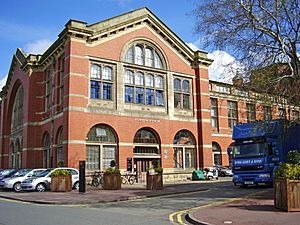
Entrance to the Lapworth Museum
|
|
| Established | 1880 |
|---|---|
| Location | Edgbaston, Birmingham, West Midlands, England |
| Type | Geological museum |
| Visitors | c. 50,000 |
| Public transit access | University railway station |
The Lapworth Museum of Geology is a geological museum run by the University of Birmingham and located on the University's campus in Edgbaston, south Birmingham, England. The museum is named after the geologist Charles Lapworth, its origins dating back to 1880. It reopened in 2016 following a £2.7 million redevelopment project that created new galleries and displays, as well as modern visitor and educational facilities.
The Lapworth Museum is free to visit; its galleries are aimed at a broad range of audiences, from families and children to undergraduate students and specialist geology groups. The galleries use the Lapworth's collections to tell the story of the evolution of life and the planet over 4.5 billion years of Earth's history, with a particular focus on how the environment, climate, plants, and animals of the English Midlands have changed over time. The Lapworth's collection includes more than 250,000 specimens of fossils, rocks and minerals that are of international scientific significance, as well as an important archive that documents key scientific discoveries and historical geologists. The Lapworth was one of five UK museums shortlisted for the Art Fund Museum of the Year Award in 2017.
Contents
Exhibition and visitor facilities
The Lapworth Museum contains three public galleries. The main hall of the Lapworth Museum forms the Evolution of Life gallery, and contains replica skeletons of the carnivorous dinosaur Allosaurus and the flying reptile Pteranodon, as well as a floor-to-ceiling rock wall showing the major rock types and explaining the rock cycle. The gallery uses the Lapworth's fossil collections to tell the story of life from the Precambrian to the present day. Animated reconstructions show the changing local environment of the Midlands at key points in Earth history, including tropical reefs in the Silurian Period, swampy rainforests in the Carboniferous Period, shallow oceans in the Jurassic Period, and ice age tundra during the Quaternary Period. The gallery also contains displays on modern biodiversity, human evolution, and the life and work of Charles Lapworth.
The Active Earth gallery explains Earth processes, including earthquakes, volcanoes, climate change and the formation of mountains. An interactive globe projector allows visitors to view datasets such as the changing positions of the continents through geological time. The Mineral Wealth gallery explores the diversity, excavation, classification and uses of minerals, and includes information on important local historical figures such as William Murdoch and Matthew Boulton, as well as gemstones and the Jewelry Quarter of Birmingham. There is also a display of fluorescent minerals that can be viewed under ultraviolet light.
Visitor facilities include a manned reception desk, a small shop and cafe, and toilets. All galleries are fully accessible. There is a dedicated education room for the delivery of educational sessions, and a small temporary exhibition space featuring changing displays. The collections and archive are accessible to academic researchers and the public on request. The Lapworth also has an extensive volunteer programme.
History
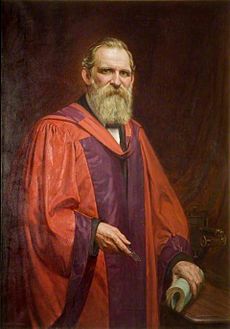
The Lapworth Museum is located within one of the wings of the Grade II* listed Aston Webb Building on the main campus of the University of Birmingham. The Aston Webb Building was designed by the architects Sir Aston Webb and Ingress Bell, and it retains many of its original Edwardian features. The Lapworth has occupied its current space from the 1920s, but the history of the Museum dates back to 1880 and the foundation of Mason College, the forerunner of the University of Birmingham. The Museum is named after Professor Charles Lapworth, an English geologist who was the first Professor of Geology at the University, and a key figure in 19th-century geological science. The Lapworth collections have long provided a teaching aid for the University of Birmingham's geology students, and are the subject of active research by palaeontologists, geologists, archaeologists and historians from the University of Birmingham and internationally.
Palaeontology (fossil) collections
The strengths of the palaeontological collections reflect the geology of the local region, as well as the research interests of past and present University of Birmingham palaeontologists. One of the most important collections is of Silurian marine animals from the 428 million-year-old Wenlock Limestone of the Dudley area. The limestone records animals living in and around ocean floor reefs when the Midlands was covered by warm, shallow tropical seas. Fossils were primarily collected during the 18th and 19th century during quarrying of the limestone for use as flux during the production of iron. Key collections made in the 19th century by Charles Ketley and Sir Charles Holcroft were acquired by the Lapworth.
The museum also includes an important collection of graptolites, marine colonial organisms that are highly important for correlating and dating rocks, as a result of the work of Charles Lapworth, who was a leading expert on the group. Other key collections include: plants and animals from the Coal Measures of the South Staffordshire Coalfield, particularly those preserved in exceptional in ironstone nodules from Coseley; ice age mammals such as mammoth and cave bear; exceptionally preserved fish fossils from Brazil, Italy, Lebanon and the USA; and specimens from famous international fossiliferous deposits such as the Solnhofen Limestone of southern Germany and the Burgess Shale of British Columbia.
Mineralogy collections
The Lapworth collections include around 12,000 minerals collected worldwide, but with particularly fine examples from the British mining areas of Cornwall, Cumbria, Shropshire and Wanlockhead. The specimens include many from collections dating back to the eighteenth and nineteenth century, an from mines long since closed. A particularly important collection is that of William Murdoch, an engineer and inventor who worked at Soho House with James Watt and Matthew Boulton.
Events and educational activities
Following the redevelopment project, the Lapworth launched a new education programme including workshops aimed at a range of key stages, all of which have been developed to link to the National Curriculum. The Lapworth is used by schools, colleges, home education groups, university and adult education groups as a teaching aid. Talks, hands on sessions and "behind the scenes" tours can be arranged for visiting groups wishing to learn more about natural history.
A new annual public lecture was established following the redevelopment of the Lapworth. The Keith Palmer Lecture Series, named after the lead individual donor to the redevelopment, was established to promote the public understanding of natural science by a distinguished invited speaker. The lectures are aimed at the non-academic community of the local region. The first Keith Palmer lecture in 2017 was given by Professor Kenneth Lacovara.
The Lapworth also organises a series of public talks, the 'Lapworth Lectures', by leading geologists and palaeontologists every other Monday, at 5pm, during term time. A full list of guest speakers and dates is provided on the Museum's website.
The Lapworth runs a variety of family activities at the University of Birmingham's annual community festival each year. Details of the community festival and planned activities are provided on the University of Birmingham website. The Lapworth also participates in other regular University of Birmingham events, such as the annual Arts & Science Festival.
Temporary exhibitions are organised several times a year within the Lapworth's temporary exhibition space.
Images for kids



